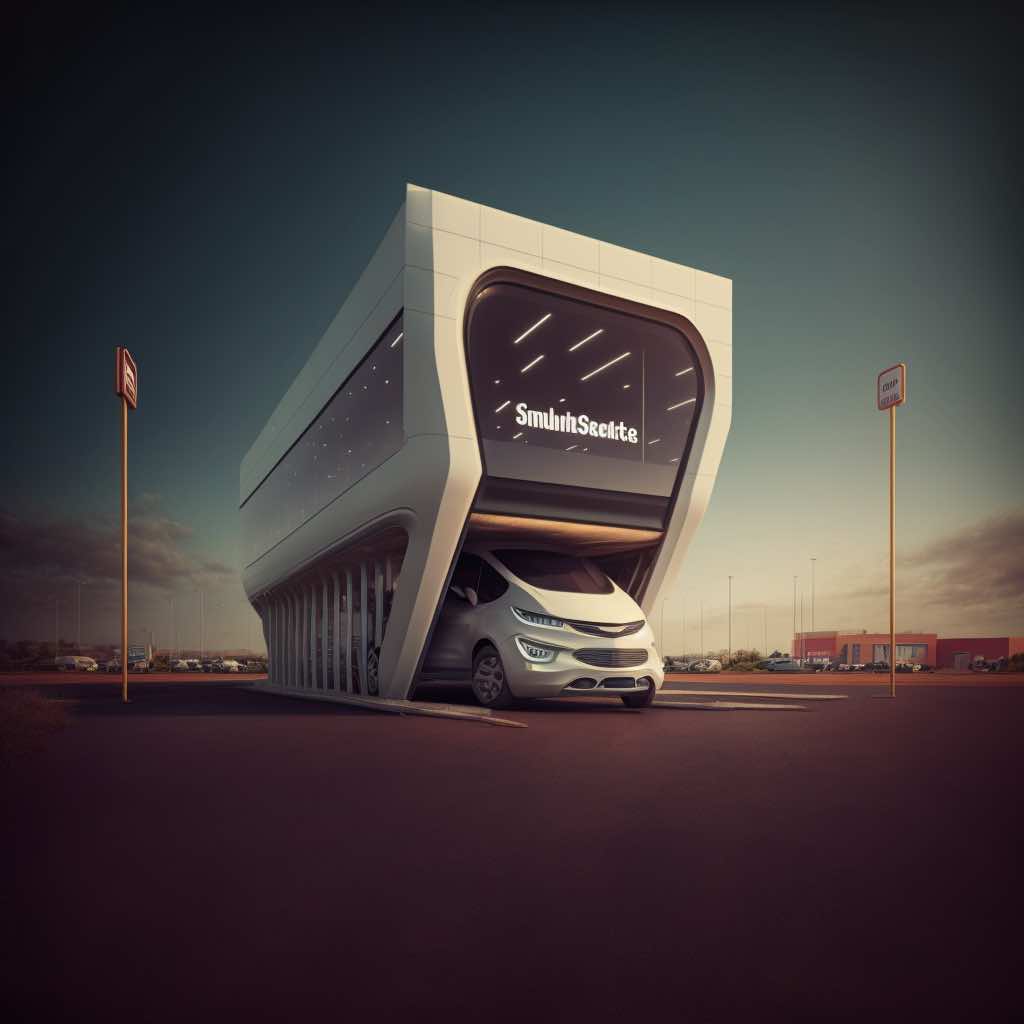Top Benefits of Automating Your Dealership's Shuttle Service

A dealership shuttle service transports customers to and from the dealership while their vehicle is being serviced or repaired. This service is often provided as a convenience to customers who need to leave the dealership while their vehicle is being worked on, or who do not have a means of transportation. Dealer shuttle service can be operated by the dealership itself or by a third-party company contracted by the dealership. Some dealerships may offer this as a complimentary service to customers, while others may charge a fee.
Table of Contents
- Alternate Uses
- Paper-based Shuttle Dispatch Process
- Disadvantages of a Paper-based Shuttle Dispatch
- Benefits of a Shuttle Software
- Top Benefits of a Dealership Courtesy Shuttle Service
- Alternatives to Shuttle Service
- Conclusion
A dealership shuttle service can provide more than just transportation for customers. It can also be utilized to support various dealership operations. For example, it can be used to transport staff members between the dealership and other off-site locations such as other dealerships, auction houses, or storage facilities, which can improve productivity and reduce the need for employees to use their own vehicles. The shuttle service can also be used to transport parts, tools, and equipment to and from the dealership or job sites, which can improve efficiency and reduce the need for multiple vehicles or deliveries. Additionally, it can be used to support dealership events, such as car shows or open houses, by providing transportation for attendees, which can improve the customer experience and create a more professional and organized event.
Overall, a dealership shuttle service can be a valuable resource for a variety of activities that go beyond transporting customers. By identifying and utilizing these additional uses, a dealership can maximize the value of their shuttle service and improve overall operations.
Paper-based Shuttle Dispatch Process
Operating a shuttle service at a dealership using manual, paper-based processes can present challenges, but it can still be effectively managed with the right approach. A basic workflow for doing so includes:
-
Establishing a reservation system: To ensure that customers are able to secure their spot in the shuttle service, create a system for them to make reservations. This can be as simple as a sign-up sheet or a reservation book.
-
Scheduling trips: In order to ensure that the shuttle service runs smoothly, determine the schedule for pick-ups and drop-offs and ensure that it aligns with the dealership's service and repair schedule.
-
Keeping a customer pick-up and drop-off log: To keep track of customer information and their vehicles, create a log that includes their names, contact information, and the make and model of their vehicles.
-
Coordinating with the service department: To ensure that customers are ready for pick-up and drop-off, coordinate with the dealership's service department.
-
Communicating with customers: To avoid confusion, communicate the schedule and pick-up/drop-off times to customers when they make their reservations, and remind them of the scheduled pickup time.
-
Conducting pick-ups and drop-offs: On the day of the pickup, check the log and make sure the customer's vehicle is ready to be picked up and that the customer is ready to be transported. Then transport the customer to the desired location, and record the drop-off time.
-
Tracking driver schedules: To ensure that the shuttle service runs smoothly, keep track of the driver schedule.
-
Following up with customers: To gather feedback and ensure customer satisfaction, follow up with customers after the shuttle service has been completed.
It is important to note that while manual processes can present challenges, they can still be effectively managed with the right approach. However, it is important to keep in mind that using digital systems may be more efficient.
Disadvantages of a Paper-based Shuttle Dispatch
A paper-based shuttle dispatch process has several disadvantages that should be considered before implementation. These include inefficiency, limited scalability, lack of real-time information, limited reporting and analysis, lack of automation, higher operational costs, and data security.
Inefficiency can arise from manual input and tracking of customer information, reservations, and schedules, which can be time-consuming and prone to errors. Limited scalability is another disadvantage as it can be challenging to scale as the dealership's business grows and the number of customers using the shuttle service increases. Additionally, a paper-based system can be difficult to get real-time information about the shuttle's location, schedule, and availability, leading to delays and confusion for customers and staff. There is also a limitation in generating reports and analyzing data on customer usage, shuttle utilization, and other key metrics. Furthermore, it doesn't have the capability to automate certain tasks such as sending notifications, generating reports, and tracking the shuttle location. It can also be more costly to operate as it requires a lot of manual tasks. Lastly, paper records can be less secure as it's easier to lose, damage, or steal the records, which can lead to data breaches and other security issues.
Dealership managers should consider these disadvantages before deciding whether to implement a paper-based system. A digital solution, such as a shuttle management software, can provide a more efficient, scalable, and secure option for managing the shuttle service.
Benefits of a Shuttle Software
Shuttle management software such as HopDrop can offer several advantages over traditional paper-based systems for dealerships. These advantages include:
-
Increased efficiency: Automating manual tasks can lead to faster and more accurate reservations, scheduling, and tracking of customer information.
-
Real-time shuttle tracking: Staff can access real-time information about the shuttle's location, schedule, and driver availability, minimizing delays and confusion for customers and staff.
-
Scalability: The software can be easily scaled to accommodate an increasing number of customers and service requests.
-
Reporting and analysis: Generating reports and analyzing data on customer usage, shuttle utilization, driver activities, and other key metrics can help staff make more informed decisions and improve the efficiency of the service.
-
Fuel efficiency: Route optimization can help reduce fuel consumption and costs associated with fuel.
-
Automation: Tasks such as sending notifications, generating reports, and tracking driver location can be automated, saving time and reducing the chances of errors.
-
Data security: Digital systems can provide better security for records and personal data, with the ability to implement security features such as encryption, access control, and data backups.
-
Mobile and web-based access: Staff and customers can access the system from anywhere, at any time, through mobile devices and web browsers.
A digital shuttle management software can offer many benefits to dealerships over traditional paper-based systems by increasing efficiency, providing real-time information, scalability, security, and automation of tasks, which can lead to improved decision making and overall efficiency of the shuttle operation.
Optimized Shuttle Operation for Better CSI Score
A shuttle software can improve the Customer Service Index (CSI) score by providing a more efficient and streamlined service that enhances the customer experience. One way it can achieve this is by providing real-time information on shuttle location, schedule, and availability, which can minimize delays and confusion for customers, ultimately improving the overall customer experience and increasing satisfaction.
The software can also automate the process of sending notifications to customers, such as pick-up and drop-off times, which can improve the customer experience by reducing uncertainty and providing them with the information they need. Additionally, it can store customers' preferences and automatically offer the best service based on their needs, which can improve the customer experience by providing a more tailored service that meets their specific needs. Furthermore, it can provide customers with an easy way to provide feedback, and track their satisfaction. It can also analyze this feedback, and use it to improve the service and increase customer satisfaction.
A shuttle software can improve the CSI score by providing a more efficient and streamlined service that enhances the customer experience. By providing real-time information, automated notifications, personalized service, and easy feedback and analysis, a shuttle software can help dealerships to improve the CSI score and provide a better customer experience.
How Shuttle Software Reduces Operating Costs
A shuttle software can help to lower operating costs for a dealership by streamlining processes, automating tasks, and providing more efficient management of the shuttle service. Here are a few ways a shuttle software can achieve this:
-
Automation of tasks: It can automate many of the manual tasks associated with a paper-based system, reducing the need for manual labor and therefore lowering labor costs.
-
Optimization of routes: The software can optimize shuttle routes by efficiently planning and scheduling them, reducing unnecessary mileage and improving overall transportation efficiency. This can lead to cost savings for the dealership through reduced fuel consumption and vehicle operating costs.
-
Improved utilization: The software can provide real-time information on shuttle utilization, which can help improve the utilization of the shuttle service, ultimately reducing costs.
-
Better coordination: The software can help coordinate between the service department and the shuttle service, which can reduce waiting times, delays, and unnecessary shuttle runs, resulting in cost savings.
-
Easier maintenance: The software can automatically schedule and track maintenance for the shuttles, which can help to reduce costs associated with maintenance and repairs.
A shuttle optimization software can help to lower operating costs for a dealership by streamlining processes, automating tasks, and providing more efficient management of the shuttle service. By reducing the need for manual labor and materials, improving efficiency, and increasing the utilization of the shuttle service, a shuttle software can help to lower operating costs and increase the dealership's bottom line.
Increase Shuttle Driver Retention
A digital shuttle solution can improve driver satisfaction and retention, and ultimately reduce administrative costs associated with driver turnover, by incorporating various tools that make the drivers' job easier and more efficient. One way it can achieve this is by automating the process of scheduling and routing drivers, reducing the time and effort required to plan and organize their work, thereby improving driver satisfaction.
The software can also provide drivers with real-time information on customer pick-ups and drop-offs, reducing the chances of confusion or delays and improving driver satisfaction. Additionally, it can be accessed through mobile devices, which can allow drivers to access the system from anywhere, at any time. This can improve driver satisfaction by providing them with the flexibility to access their schedule and other important information when they need it. Furthermore, it can automatically generate reports on driver performance, customer feedback, and other key metrics. This can improve driver satisfaction by providing them with feedback on their performance and the opportunity to improve.
In addition to the above, a shuttle software can also include features such as incentive programs, job tracking, and communication tools to improve the driver's experience. Overall, a digital solution can improve driver satisfaction and retention by providing tools that make their job easier and more efficient, which in turn reduces administrative costs associated with driver turnover.
Top Benefits of a Dealership Courtesy Shuttle Service
Implementing a courtesy shuttle service can provide a dealership with several advantages, including:
-
Improved customer satisfaction: Offering a shuttle service can be a valuable convenience for customers, allowing them to leave their vehicle for service or repair without having to arrange for alternative transportation. This can result in increased customer satisfaction and loyalty.
-
Increased sales and revenue: A shuttle service can aid in increasing sales and revenue by providing a convenient means for customers to test drive vehicles or visit the dealership, which can increase the likelihood of them making a purchase or lease.
-
Greater efficiency: A shuttle service can help increase efficiency by reducing the need for customers to wait for their vehicles to be serviced or repaired. This can lead to increased productivity and revenue for the dealership.
-
Increased brand awareness: A shuttle service can help to raise brand awareness by providing a visible and tangible way for the dealership to demonstrate its commitment to customer service and convenience.
-
Competitive edge: A shuttle service can give a dealership an edge over other dealerships that do not offer this service, which can help attract and retain customers.
In conclusion, a shuttle service can provide a dealership with a wide range of benefits, including improved customer satisfaction, increased sales and revenue, greater efficiency, increased employee satisfaction, increased brand awareness, a competitive advantage, cost savings and increased customer retention.
- Valet pick-up and delivery: This service entails the dealership dispatching a driver to the customer's location to retrieve their vehicle for service or repair. Once the work is completed, the driver returns the vehicle to the customer's location. This service is a convenient choice for customers who are unable to drop off or collect their vehicle at the dealership, and also demonstrates that the dealership is willing to go above and beyond to meet the needs of its customers.
- Taxi or ride-sharing services: Another alternative transportation option is providing customers with vouchers or reimbursement for taxi or ride-sharing services like Uber or Lyft. This option is useful for customers who prefer not to use a shuttle service or for those who live in an area that is not serviced by the dealership's shuttle service.
- Loaner car: A loaner car is yet another alternative transportation option that a dealership can provide to its customers. This service allows customers to borrow a car from the dealership while their vehicle is being serviced or repaired. This is an excellent option for customers who need to continue their daily activities and cannot wait for their vehicle to be repaired.
Each of these alternative transportation options has its own advantages and disadvantages, and the best option for a dealership will depend on its location, resources, and customer base. Factors such as cost, customer demand, and feasibility should be taken into account when deciding which alternative transportation option to offer.
Conclusion
In summary, our discussion centered around the potential benefits and drawbacks of implementing a shuttle service as a transportation option for customers at a dealership. We highlighted the advantages of utilizing digital shuttle software, such as increased efficiency and reduced operating costs when compared to traditional, paper-based systems. Additionally, we noted how utilizing a shuttle software can positively impact the customer service index (CSI) score by providing a more efficient and streamlined service that enhances the overall customer experience. Furthermore, we emphasized the potential for a shuttle software to improve driver satisfaction and retention, which can in turn decrease administrative costs associated with driver turnover.
In addition to a shuttle service, we also discussed three alternative transportation options available to dealerships, including valet pick-up and delivery, utilizing taxi or ride-sharing services like Uber and Lyft, and offering loaner cars. Each of these options possess their own unique benefits and drawbacks, and the optimal choice for a dealership will depend on its specific location, resources, and customer demographic.
It is important to keep in mind that offering a transportation option to customers is becoming increasingly crucial for dealerships to remain competitive in today's market. With the ease of online shopping and the ability for customers to compare prices and services across different dealerships, customers have more options than ever before. By providing a shuttle service, or other transportation options, dealerships can differentiate themselves from competitors and offer a valuable service that can increase customer satisfaction and loyalty.

